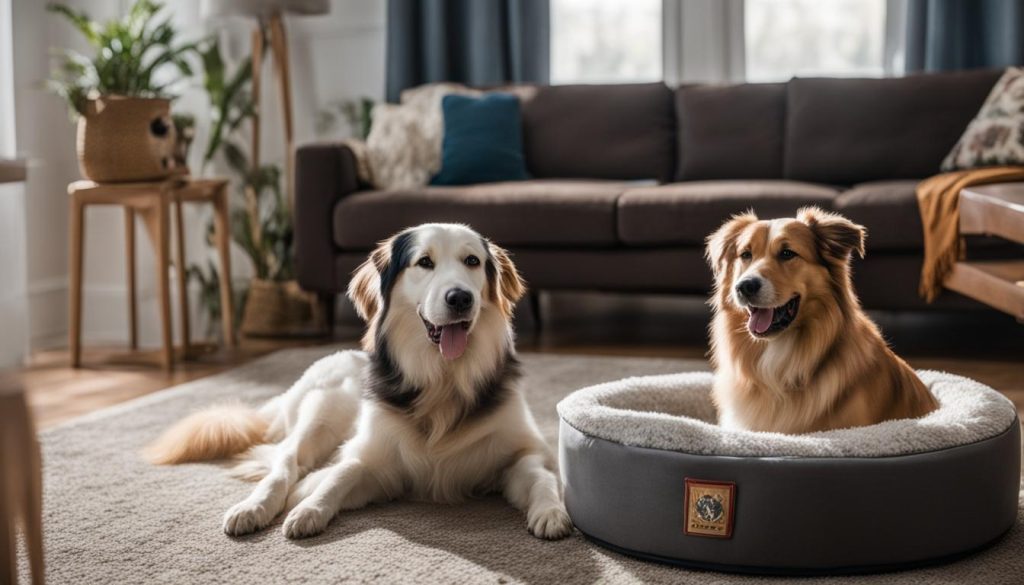As a dog owner, you may have wondered if your furry friend would be happier with a companion. Dogs are highly social creatures, and the idea of providing them with a playmate and a constant companion can be enticing. However, before making the decision to bring another dog into your home, it is good practice to consider various factors to ensure the happiness and well-being of both dogs.
Introducing a second dog to your household can have numerous benefits, including increased companionship, enhanced socialization opportunities, and reduced feelings of loneliness and boredom for your furry friends. However, it is essential to navigate the process with care, as rushing the decision or neglecting important considerations can lead to compatibility issues and potential behavioral problems.
Key Takeaways:
- Adding a second dog can provide companionship, socialization, and entertainment for your existing dog.
- Consider the compatibility between the existing dog and the potential second dog, including their personalities, energy levels, and play styles.
- Properly introducing the dogs and allowing them to establish a positive relationship is crucial for a harmonious household.
- Having a second dog can help prevent loneliness and boredom, reducing the risk of behavioral issues in your furry friends.
- Adopting a second dog can save a life and provide a loving home for a deserving animal.
Dogs are happier with companions
It is widely known that dogs are highly social creatures and thrive on companionship. They are inherently social animals and naturally seek out social interaction with other dogs. Canine companionship plays a crucial role in their overall well-being and happiness.
Constant companionship is an essential aspect of a dog’s life. Having another dog as a companion provides them with the opportunity for social interaction, play, and emotional support. Dogs who have a playmate in the form of another dog are less likely to experience feelings of loneliness and boredom, which can often lead to behavioral issues such as separation anxiety or destructive behaviors.
Having a companion dog allows dogs to engage in natural canine behaviors, such as chasing, wrestling, and playing together. These interactions provide mental stimulation, physical exercise, and emotional fulfillment. Dogs with constant companionship are generally happier and more content, leading to a healthier and more balanced overall well-being.
Ultimately, the addition of a second dog to the household can greatly enhance the quality of life for both dogs involved. The benefits of having a companion for a dog extend beyond simple companionship, offering emotional support, social interaction, and a sense of belonging. Dogs are happier when they have the opportunity to socialize and interact with their own species, and having a companion dog can provide them with this invaluable experience.

Dogs thrive on social interaction
You should understand that dogs are social creatures by nature. They have a strong instinct to bond and form relationships, not just with humans but also with other dogs. Canine companionship is a vital component of their well-being, contributing to their overall happiness and fulfillment.
“Having another dog as a companion provides them with the opportunity for social interaction, play, and emotional support.”
By providing dogs with constant companionship and the chance to socialize with their own species, we are meeting their innate social needs and enriching their lives. Dogs communicate and interact in ways that are unique to their species, and having a companion dog allows them to engage in these natural behaviors. This can have a positive impact on their mental and emotional state, leading to improved behavior and a happier overall disposition.
To sum it up, dogs are happier with companions. They thrive on social interaction and benefit greatly from having a companion dog. Canine companionship provides dogs with constant companionship, emotional support, and the opportunity to engage in natural behaviors. Adding a second dog to the household can greatly enhance the well-being and happiness of both dogs involved, creating a harmonious and fulfilling environment for them to thrive.
Factors to Consider When Getting a Second Dog
When considering getting a second dog, take into account several factors to ensure a successful companionship between the two dogs. Compatibility is a key consideration, as matching the energy level, temperament, and play style of the second dog with the existing dog will help minimize the risk of personality clashes and conflicts. I highly suggest that you choose a dog that will complement the dynamics of your household and create a harmonious environment.
Introducing a second dog to your home should be done gradually and on neutral ground. This allows the dogs to establish a positive relationship without territorial tensions. By providing controlled interactions and closely monitoring their body language, you can help the dogs build trust and form a bond over time. I recommend that you remember that each dog is unique, and patience is necessary during the introduction process.
H3: Tips for Introducing a Second Dog
- Choose a neutral location for the initial meeting
- Keep both dogs on a loose leash or head halter
- Closely monitor their body language during the interaction
- Intervene if necessary to prevent any signs of aggression or discomfort
By taking these factors into consideration and following the proper introduction techniques, you can increase the chances of a successful integration and create a harmonious relationship between your dogs. To put it simply, each dog is an individual, so assess their compatibility and ensure their needs and personalities align before making the decision to add a second dog to your household.

| Factors to Consider | Why It’s Important |
|---|---|
| Compatibility | Matching energy level, temperament, and play style reduces conflicts |
| Gradual Introduction | Allows dogs to establish a positive relationship on neutral ground |
| Monitoring Body Language | Helps identify signs of aggression or discomfort, ensuring a safe interaction |
The importance of choosing the right dog
When adding a second dog to your family, it is good practice to choose the right dog that will fit well with your existing dog. Consider factors such as size, breed, and activity level to ensure compatibility and a harmonious relationship between the dogs. Dogs with similar exercise capacities and interests are more likely to get along well and enjoy each other’s company.
Size is an important consideration when selecting a second dog. A significant size difference between the two dogs can lead to potential conflicts and difficulties in their interactions. It is generally advisable to choose a second dog that is similar in size or slightly smaller than your existing dog to minimize any potential dominance or territorial issues.
Breed considerations are also crucial when choosing a second dog. Different breeds have different energy levels, temperaments, and play styles. I recommend that you select a breed that complements your existing dog’s traits and suits your family’s lifestyle. For example, if you have an active and energetic dog, it may be beneficial to choose a second dog with a similar energy level to ensure they can engage in compatible play and exercise.
| Breed | Size | Activity Level |
|---|---|---|
| Labrador Retriever | Large | High |
| Beagle | Medium | Moderate |
| Shih Tzu | Small | Low |
Activity level compatibility is another vital factor to consider when choosing a second dog. Dogs with similar activity levels are more likely to enjoy engaging in similar types and amounts of physical exercise. This can help prevent potential frustration or conflict if one dog has significantly higher energy demands than the other. Assessing the activity level of your existing dog and selecting a second dog with a similar level can contribute to the overall harmony and happiness of both dogs.
The importance of size and breed considerations
When choosing a second dog, you should take size and breed into consideration. Dogs of similar size and compatible breeds are more likely to get along well and have harmonious interactions. Selecting a dog with a similar energy level to your existing dog can further enhance their compatibility and ensure they can engage in enjoyable activities together. By carefully considering these factors, you can increase the likelihood of a successful and fulfilling companionship between your dogs.

Benefits of Having Two Dogs
Having two dogs in the home can bring a multitude of benefits for both the dogs and their owners. Let’s explore some of the advantages of having two canine companions.
“Dogs are not our whole life, but they make our lives whole.” – Roger Caras
1. Company and Entertainment: One of the most obvious benefits of having two dogs is the constant companionship and entertainment they provide to each other. Dogs are social creatures, and having a playmate can help reduce feelings of loneliness and boredom. They can engage in play, chase each other around the yard, and even cuddle up together for a nap, providing endless enjoyment for both the dogs and their owners.
2. Learning From Each Other: Another advantage of having two dogs is the opportunity for them to learn from each other. Older dogs can teach younger dogs important manners and house rules, helping in their training and socialization. Dogs are highly observant animals, and they often mimic desirable behaviors from their fellow furry friends, leading to a more well-behaved and balanced canine family.
3. Reducing Separation Anxiety: Dogs with separation anxiety can benefit greatly from having a companion. The presence of another dog can help alleviate anxiety when left alone, as they have a constant source of comfort and security. This can lead to a significant reduction in destructive behaviors and stress-related issues, creating a calmer and happier environment for both dogs and their owners.
4. Saving Lives: Adopting a second dog not only provides benefits for your current dog but also saves a life. Many dogs are in shelters waiting for their forever homes, and by opening your heart and home to another dog, you are giving them a second chance at a happy and loving life. It’s a win-win situation where two dogs get to experience the joy of a forever home.

| Benefits of Having Two Dogs |
|---|
| Company and Entertainment |
| Learning From Each Other |
| Reducing Separation Anxiety |
| Saving Lives |
Sharing the Workload and Expenses
Having two dogs in the household can offer several benefits, including the opportunity to share the workload and expenses associated with caring for them. When you have two dogs, you can divide responsibilities such as walking, feeding, and grooming between them, reducing the workload for each individual owner. This can be particularly helpful for those with busy schedules or limited physical capabilities.
In addition to sharing the workload, owning multiple dogs can also lead to cost savings. Many supplies, such as toys, beds, and grooming products, can be shared between the dogs, resulting in reduced expenses. Furthermore, bulk purchasing of items like food and medications for multiple dogs can often lead to discounts or cost savings in the long run.
“Having two dogs in the household can be beneficial as it allows for the workload to be shared and can result in reduced financial burden.”
While there may be additional costs associated with having a second dog, such as veterinary care and training, the overall financial impact may not be significantly higher compared to having just one dog. By carefully managing expenses and taking advantage of shared supplies and resources, the financial burden can be minimized.
| Expense | Single Dog | Two Dogs |
|---|---|---|
| Veterinary Care | $500 per year | $900 per year (including preventive care) |
| Food | $50 per month | $75 per month |
| Grooming | $30 per month | $45 per month (shared grooming supplies) |
As shown in the table, while there are additional expenses associated with owning two dogs, the difference may not be as significant as one might expect. By carefully managing and budgeting for the expenses, the financial impact can be easily manageable, especially when considering the shared supplies and reduced workload.
Overall, sharing the workload and expenses between two dogs can be a practical and cost-effective solution for dog owners. It allows for a more balanced distribution of responsibilities and can result in reduced financial burden without compromising the well-being of the dogs.

Introducing a Second Dog to Your Household
Preparing for the introduction of a second dog to your household requires careful planning and consideration. The initial meeting should take place on neutral ground to avoid territorial aggression. Choosing a location such as a nearby park or a friend’s backyard can help create a neutral environment for both dogs.
During the introduction, keep both dogs on a loose leash or a head halter to maintain control. This allows you to guide their interactions and prevent any potential conflicts. Allow the dogs to approach each other at their own pace, while closely monitoring their body language. Positive signs such as loose and relaxed postures indicate a friendly interaction, while signs of tension or aggression should be addressed immediately.
Controlled interactions are key to a successful introduction. Gradually increase the duration of the interactions, always ensuring the safety of both dogs. If any signs of aggression or discomfort persist, consult with a professional dog trainer or behaviorist for guidance. To put it simply, each dog is unique, and it may take time for them to adjust and form a bond.
Factors to Consider:
- Choose a neutral location for the initial meeting
- Keep both dogs on a loose leash or head halter
- Monitor their body language closely
- Address any signs of aggression or discomfort
- Seek professional guidance if needed

Introducing a second dog to your household can be a rewarding experience for both you and your existing dog. By following these guidelines and being patient, you can increase the chances of a successful introduction and foster a harmonious relationship between your dogs.
Establishing a Harmonious Relationship
When introducing a second dog to your household, you should focus on establishing a harmonious relationship between the dogs. This involves considering the hierarchy within the pack and managing resources effectively. By implementing gradual integration and proper resource management, you can create a peaceful environment for your furry companions.
Hierarchy:
Allowing dogs to establish a hierarchy is a natural process that helps prevent conflicts. I would recommend to respect their natural order and avoid interfering unless aggression or extreme dominance occurs. Each dog should have their own space and belongings to minimize competition and potential resource guarding.
Resource Management:
Effective resource management is crucial for maintaining peace and preventing conflicts. Each dog should have their own food and water bowls, separate beds, and designated play areas. By ensuring that each dog has their own resources, you can avoid unnecessary tension and potential aggression. You should monitor the dogs during meal times and offer treats or rewards separately to prevent any food-related conflicts.
Gradual Integration:
Gradual integration is key to establishing a harmonious relationship between dogs. Start by allowing the dogs to have supervised interactions on neutral ground, gradually increasing their time together. Pay attention to their body language and intervene if any signs of discomfort or aggression arise. By slowly introducing the dogs and providing positive reinforcement for good behavior, you can help them build a strong bond and minimize the chances of conflicts.
| Key Points to Establish a Harmonious Relationship |
|---|
| Respect the natural hierarchy within the pack |
| Allow each dog to have their own space and belongings |
| Practice effective resource management to prevent conflicts |
| Introduce the dogs gradually and provide positive reinforcement |
Creating a harmonious relationship between dogs requires patience, consistency, and understanding. By respecting their natural order, managing resources effectively, and gradually integrating them, you can foster a peaceful and loving environment for your furry family members.

Addressing Separation Anxiety in Dogs
Separation anxiety is a common issue among dogs and can cause distress for both the dog and their owner. If your dog is experiencing separation anxiety, you should address the issue promptly to improve their well-being. Seeking professional help and considering a companion for your anxious dog are potential solutions to explore.
When dealing with separation anxiety, consulting with a professional, such as a veterinarian or a certified dog behaviorist, is crucial. These experts can assess your dog’s specific needs and provide tailored advice to address their anxiety. They may recommend behavior modification techniques, training exercises, or even medication to help alleviate your dog’s separation anxiety.
Introducing a companion for your anxious dog can also be considered as part of the treatment plan. Having a second dog in the household can provide companionship and reduce feelings of loneliness and anxiety. However, you should note that not all dogs will benefit from the addition of another dog. Each dog has unique needs and preferences, and some may not be comfortable or compatible with a new canine companion.
“A second dog can provide companionship and reduce feelings of loneliness and anxiety.”
Considerations when choosing a companion for an anxious dog
- Temperament: Look for a dog with a calm and gentle temperament that can provide a calming influence for your anxious dog.
- Size and energy level: Consider a companion dog that is similar in size and energy level to your anxious dog. A dog that matches your dog’s activity level can engage in play and exercise, promoting mental and physical stimulation.
- Compatibility: Slowly introduce the potential companion dog to your anxious dog in a controlled and supervised manner. Observe their interactions and body language to ensure they get along well and have a positive relationship.
To put it simply, every dog is unique, and what works for one may not work for another. You should also consult with professionals and consider the specific needs of your anxious dog before making any decisions. Together with expert guidance and thoughtful consideration, addressing separation anxiety and finding a suitable companion can bring comfort and relief to your beloved pet.

Considerations for Multiple Dog Households
Managing multiple dogs in a household requires careful attention and supervision. Each dog has unique needs and should receive individual attention to prevent feelings of neglect or competition. Providing sufficient exercise, training, and affection to each dog is essential for their overall well-being. Additionally, establishing a consistent routine for feeding, walking, and playtime can help maintain a harmonious environment.
Supervision is crucial during interactions between multiple dogs to ensure their safety and prevent any potential conflicts. Always monitor their body language and intervene if necessary to prevent any aggressive behavior. It is also important to provide each dog with their own space, such as separate beds or crates, to give them a sense of security and personal territory.
Creating a structured environment with clear rules and boundaries can help prevent any dominance issues or resource guarding between the dogs. Each dog should have their own food and water bowls, toys, and designated areas for resting. By establishing a fair and consistent system, you can ensure that each dog feels secure and valued within the household.
| Managing Multiple Dogs in a Household | Benefits |
|---|---|
| Giving individual attention and meeting each dog’s needs | Prevents feelings of neglect or competition |
| Supervising interactions between dogs | Ensures their safety and prevents conflicts |
| Establishing a consistent routine | Maintains a harmonious environment |
| Providing separate spaces and resources | Prevents dominance issues and resource guarding |
| Creating a structured environment with clear rules | Ensures a fair and balanced hierarchy |
Overall, managing multiple dogs requires careful attention to their individual needs and the establishment of a structured and balanced environment. By providing individual attention, supervision, and clear boundaries, you can create a harmonious household where all dogs can thrive and enjoy their lives together.

The Financial Aspect of Having Two Dogs
Adding a second dog to your household can be a wonderful decision, but consider the financial implications. While there are additional costs associated with owning multiple dogs, there are also opportunities for shared expenses that can help alleviate some of the financial burden.
When it comes to the cost of owning multiple dogs, there are a few key areas to consider. First, there is the cost of food. With two dogs, you’ll need to budget for twice the amount of food each month. However, buying in bulk or finding deals from local suppliers can help lower this expense. Additionally, many pet stores offer loyalty programs or discounts for purchasing larger quantities, which can further reduce costs.
Veterinary care is another important consideration. You’ll need to budget for regular check-ups, vaccinations, and preventive medications for both dogs. While this cost will double with two dogs, some veterinarians offer discounts for multiple pets or package deals for services. It’s worth researching different veterinary clinics in your area to find the best options for affordable care.
| Expense | Cost for one dog | Cost for two dogs |
|---|---|---|
| Food | $50 per month | $100 per month |
| Veterinary Care | $500 per year | $1000 per year |
| Grooming | $40 per session | $80 per session |
| Supplies | $200 per year | $400 per year |
Grooming and supplies are additional expenses to consider. While grooming costs may double with two dogs, there are often discounts available for multiple pets. It’s also worth considering whether you can handle basic grooming tasks at home to save money.
Overall, while there are increased costs associated with having two dogs, many expenses can be shared between the dogs, helping to reduce the financial impact. Proper budgeting and research can go a long way in ensuring that you can provide the necessary care for multiple furry companions without breaking the bank.

Final Thoughts
After considering the various factors involved in adding a second dog to your household, it is clear that there are both benefits and considerations to be mindful of. Dogs are social creatures and can greatly benefit from the companionship and interaction that another dog can provide. They can keep each other company, reduce feelings of loneliness, and provide entertainment for one another.
However, you should carefully consider the compatibility between the existing dog and the potential second dog. Rushing into the decision or choosing a dog solely for companionship can lead to personality clashes and compatibility issues. Taking the time to choose a dog that is compatible in terms of energy level, temperament, and play style can greatly increase the chances of a successful and harmonious relationship between the dogs.
Proper introductions and gradual integration are also crucial when adding a second dog to your household. Choosing a neutral location for the initial meeting, closely monitoring the dogs’ body language, and allowing them to establish a positive relationship can help set the foundation for a strong bond. You should provide individual attention to each dog and address any potential issues or concerns that may arise.
To sum it up, the decision to add a second dog to your household should be based on careful consideration of your current dog’s needs and dynamics, as well as your commitment to providing a loving and harmonious home for both animals. With proper planning, introductions, and ongoing management, having two dogs can be a rewarding experience for both you and your furry companions.
FAQ
Would my dog be happier with a second dog?
Dogs are highly social creatures and often having another dog can provide companionship and prevent feelings of loneliness and boredom. However, you should consider the dynamics and compatibility between the existing dog and the potential second dog.
What factors should I consider when getting a second dog?
You might want to consider factors such as energy level, temperament, and play style to ensure compatibility between the existing dog and the potential second dog. Rushing the decision or choosing a dog solely for companionship can lead to personality clashes and compatibility issues.
How do I introduce a second dog to my household?
You should choose a neutral location for the initial meeting and introduce the dogs slowly. Allowing them to investigate each other while closely monitoring their body language can help establish a positive relationship.
What are the benefits of having two dogs?
Having two dogs can provide companionship, entertainment, and learning opportunities. They can keep each other company, reduce boredom and destructive behaviors, and older dogs can help teach younger dogs manners and house rules.
How do I manage the workload and expenses of having two dogs?
Many supplies can be shared between the dogs, reducing costs. Additionally, responsibilities such as walking, feeding, and grooming can be shared between the dogs, reducing the workload for each individual.
How can I establish a harmonious relationship between my dogs?
Each dog should have their own resources, such as food bowls and beds, to prevent resource guarding. Gradual integration and providing individual attention can help foster a harmonious relationship.
What should I do if my dog has separation anxiety?
You should consult with a veterinarian or professional behaviorist to determine the best course of action. Adding a second dog may not always be the solution and could potentially increase anxiety levels.
How do I manage a multiple dog household?
Each dog should receive individual attention and have their needs met to prevent feelings of neglect or competition. Supervision during playtime and training sessions is essential to ensure the safety and well-being of all dogs involved.
What are the financial considerations of having two dogs?
While there are additional costs associated with owning two dogs, such as food and veterinary care, many expenses can be shared between the dogs. Sharing supplies and budgeting for the financial responsibilities can help ensure both dogs receive the care they need.
Final Thoughts
Adding a second dog to your household can provide numerous benefits, but you should carefully consider the compatibility and dynamics between the dogs. Proper introductions and gradual integration, along with individual attention and supervision, can help establish a harmonious relationship between the dogs.






